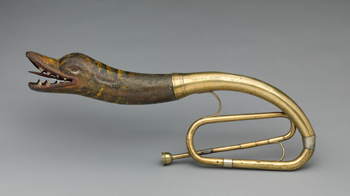Photo courtesy of the Cincinnati Art Museum
Several years ago, I saw an exhibit at the American Museum of Natural History in New York about what makes us human. The ability to make music came up as one of the elements that distinguish us from other primates.
Recently, scientists have stated that the oldest discovered instruments—flutes made from bird bone and mammoth ivory—date back more than 40,000 years.
In August, I had the privilege of attending “The Art of Sound: Four Centuries of Musical Instruments” at the Cincinnati Art Museum. The exhibit showcased more than 125 instruments, selected for their artistic qualities. “Their makers designed, crafted and embellished them to look as intriguing and beautiful as the sounds that they produce,” explained museum signage. “These instruments demonstrate both the shared human need to express oneself creatively and the importance of the arts (visual as well as performing) to the strength and traditions of communities across the world.”
Intricate carvings, paintings, feathers and gems adorned the instruments. Some of them had been designed to resemble animals. There was a rattle shaped like a raven, a zither carved as an alligator and a mayuri stringed instrument designed like a peacock.
Two instruments stood out in particular to be important to the marching world: a 19th century “serpent,” the bass member of the cornet family, with a meandering body and six finger holes; and a 19th century horn (pictured).
“This brass horn terminates in the painted, metal head of a sea dragon,” signage said. “The creature’s tongue is mounted on a spring, allowing it to move while the instrument is played. This head (or bell) is from a buccin, a relative of the trombone that was made in Belgium and was popular among European military bands in the second quarter of the 19th century. The remainder of this horn was constructed at a later date in order to give new life to a very entertaining buccin head.”
I was amazed to see the evolution of the various instruments and thought that you would be interested to learn about this little piece of history, too.
Visit www.cincinnatiartmuseum.org for more information about “The Art of Sound” exhibit.
Have a Musical Day!
Christine Ngeo Katzman
Publisher & Editor-in-Chief
Correction: In our July/August 2012 issue, we incorrectly stated that Blaise Castaldo had served as a co-director of the Hawthorne (N.J.) Caballeros. Rather, he had held that role with the Kingston (N.Y.) Indians in the mid-‘70s. Also, only one of his three children had marched with the Caballeros. We regret the errors.


